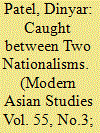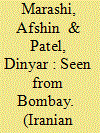|
|
|
Sort Order |
|
|
|
Items / Page
|
|
|
|
|
|
|
| Srl | Item |
| 1 |
ID:
179908


|
|
|
|
|
| Summary/Abstract |
In 1922, a group of wealthy Parsis in Bombay founded an organization that they dubbed the Iran League. Originally designed to assist their fellow Zoroastrians in Iran, who had suffered from centuries of oppression, the League quickly expanded its objectives to include the promotion of broader Indo-Iranian cultural and economic relations. It became a major player in the flow of ideas, literature, business, and tourist traffic between the two countries. Parsi fervour for Iran stemmed from the brand of Iranian nationalism promoted by Reza Shah, which celebrated the country's Zoroastrian past. In response, the League's leaders argued that the Parsis of India could play a special role in the ‘regeneration’ of Iran under the shah's supposedly benign rule. By the 1930s, however, Parsis’ embrace of Iranian nationalism became a clear reflection of their deep concerns about Indian nationalist politics: they cast Iran as an idealized alternative to contemporary India, where the Indian National Congress had supposedly taken an ominously ‘anti-Parsi’ turn. The Iran League, therefore, was caught between two nationalisms. Worry about India's future even prompted some Parsis to argue that their community should ‘return’ to their ancestral homeland of Iran. The story of the Iran League thus demonstrates the complex position of minorities vis-à-vis the brands of nationalism in development during the interwar years. The Parsis, a wealthy but microscopic minority, responded to political anxieties at home by romanticizing a foreign country and taking part in a wholly foreign nationalist project.
|
|
|
|
|
|
|
|
|
|
|
|
|
|
|
|
| 2 |
ID:
189070


|
|
|
|
|
| Summary/Abstract |
This photo essay provides a visual archive of Parsi philanthropic efforts toward the Iranian Zoroastrian communities of Yazd, Kerman, and Tehran during the 1930s. The essay reproduces a collection of photographs from a photo album produced by the Iranian Zoroastrian Anjoman (est. 1918) for the benefit of Parsi audiences in Bombay. These photographs were taken and compiled by administrators of the Parsi-funded charities in order to demonstrate to Bombay-based Parsi benefactors how their charity efforts were being used inside Iran. The essay also discusses the importance of including visual archival material as part of the social and cultural history of modern Iran, as well as the unique sets of challenges that such archival preservation represents.
|
|
|
|
|
|
|
|
|
|
|
|
|
|
|
|
| 3 |
ID:
189066


|
|
|
|
|
| Summary/Abstract |
A hundred years ago in colonial Bombay, on September 10, 1922, a group of Parsis established an organization called the Iran League. Meant to strengthen ties with their Iranian Zoroastrian coreligionists inside Iran, the Iran League also endeavored to recast wider economic and cultural relations between India and the country which Parsis regarded as their ancient homeland. That ancient homeland, after all, was undergoing seismic change. In the years following Reza Khan's 1921 coup and the establishment of the Pahlavi dynasty in 1925, Parsis watched with growing anticipation and excitement as Iran's new leader increasingly promoted a new national culture rooted in Iran's ancient past. Prominent Parsis, many of them leaders in the Iran League, fervently believed that Pahlavi Iran would herald all sorts of progressive change: improved conditions for the Iranian Zoroastrians, deeper appreciation of Zoroastrianism among Iran's Muslim majority, conditions for significant Parsi investment in Iran, and even the possibility of a mass Parsi “return” to the shah's domain, reversing the direction of centuries of Zoroastrian migration.
|
|
|
|
|
|
|
|
|
|
|
|
|
|
|
|
|
|
|
|
|